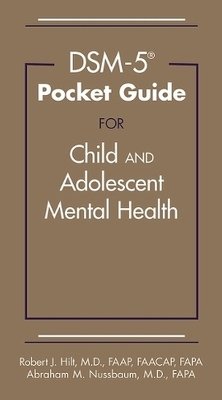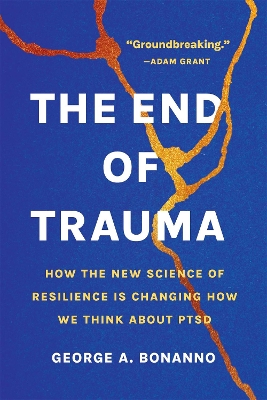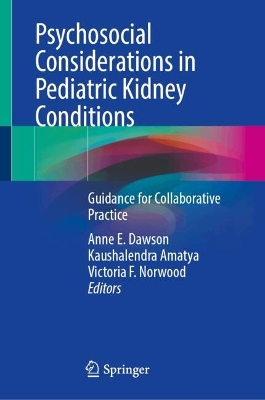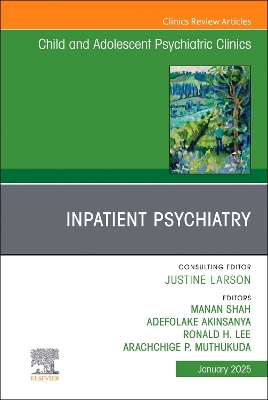DSM-5-TR (R) Pocket Guide for Child and Adolescent Mental Health
 portes grátis
portes grátis
DSM-5-TR (R) Pocket Guide for Child and Adolescent Mental Health
Nussbaum, Abraham M.; Hilt, Robert J.
American Psychiatric Association Publishing
12/2024
396
Mole
9781615375462
15 a 20 dias
Descrição não disponível.
Preface
SECTION I: MEETING, DIAGNOSING, AND TREATING CHILDREN AND ADOLESCENTS
Chapter 1. Starting Out with A Therapeutic Alliance
Chapter 2. Meeting a Young Person Experiencing Mental Distress
Chapter 3. Engaging a Young Person Experiencing a Mental Health Crisis
Chapter 4. Working Together on Common Clinical Concerns
Chapter 5. Reaching a DSM-5-TR Diagnosis When You Have 15 Minutes
Chapter 6. Reaching a DSM-5-TR Diagnosis When You Have 30 Minutes
SECTION II: ENGAGING CHILDREN AND ADOLESCENTS WITH DSM-5-TR
Chapter 7. Reaching a DSM-5-TR Diagnosis When You Have 45 Minutes or More
Chapter 8. Recalling Common DSM-5-TR Diagnoses Through Tables
Chapter 9. Taking Six-Steps to a Differential Diagnosis
Chapter 10. Organizing a Comprehensive Pediatric Mental Status Examination with a Psychiatric Glossary
SECTION III: ADDITIONAL TOOLS AND CLINICAL GUIDANCE
Chapter 11. Using DSM-5-TR Assessment Measures to Aid Diagnosis
Chapter 12. Employing Rates Scales and Alternative Di-agnostic Systems while Assessing a Young Person
Chapter 13. Recognizing Developmental Red Flags
Chapter 14. Crafting Pediatric Mental Health Treatment Plans
Chapter 15. Initiating Psychosocial Interventions
Chapter 16. Starting a Psychotherapy
Chapter 17. Initiating Medications and Monitoring for Adverse Effects
Chapter 18. Advancing Mental Health Care for Young People Through Practice, Education, Research, and Advocacy
References
Index
SECTION I: MEETING, DIAGNOSING, AND TREATING CHILDREN AND ADOLESCENTS
Chapter 1. Starting Out with A Therapeutic Alliance
Chapter 2. Meeting a Young Person Experiencing Mental Distress
Chapter 3. Engaging a Young Person Experiencing a Mental Health Crisis
Chapter 4. Working Together on Common Clinical Concerns
Chapter 5. Reaching a DSM-5-TR Diagnosis When You Have 15 Minutes
Chapter 6. Reaching a DSM-5-TR Diagnosis When You Have 30 Minutes
SECTION II: ENGAGING CHILDREN AND ADOLESCENTS WITH DSM-5-TR
Chapter 7. Reaching a DSM-5-TR Diagnosis When You Have 45 Minutes or More
Chapter 8. Recalling Common DSM-5-TR Diagnoses Through Tables
Chapter 9. Taking Six-Steps to a Differential Diagnosis
Chapter 10. Organizing a Comprehensive Pediatric Mental Status Examination with a Psychiatric Glossary
SECTION III: ADDITIONAL TOOLS AND CLINICAL GUIDANCE
Chapter 11. Using DSM-5-TR Assessment Measures to Aid Diagnosis
Chapter 12. Employing Rates Scales and Alternative Di-agnostic Systems while Assessing a Young Person
Chapter 13. Recognizing Developmental Red Flags
Chapter 14. Crafting Pediatric Mental Health Treatment Plans
Chapter 15. Initiating Psychosocial Interventions
Chapter 16. Starting a Psychotherapy
Chapter 17. Initiating Medications and Monitoring for Adverse Effects
Chapter 18. Advancing Mental Health Care for Young People Through Practice, Education, Research, and Advocacy
References
Index
Este título pertence ao(s) assunto(s) indicados(s). Para ver outros títulos clique no assunto desejado.
Preface
SECTION I: MEETING, DIAGNOSING, AND TREATING CHILDREN AND ADOLESCENTS
Chapter 1. Starting Out with A Therapeutic Alliance
Chapter 2. Meeting a Young Person Experiencing Mental Distress
Chapter 3. Engaging a Young Person Experiencing a Mental Health Crisis
Chapter 4. Working Together on Common Clinical Concerns
Chapter 5. Reaching a DSM-5-TR Diagnosis When You Have 15 Minutes
Chapter 6. Reaching a DSM-5-TR Diagnosis When You Have 30 Minutes
SECTION II: ENGAGING CHILDREN AND ADOLESCENTS WITH DSM-5-TR
Chapter 7. Reaching a DSM-5-TR Diagnosis When You Have 45 Minutes or More
Chapter 8. Recalling Common DSM-5-TR Diagnoses Through Tables
Chapter 9. Taking Six-Steps to a Differential Diagnosis
Chapter 10. Organizing a Comprehensive Pediatric Mental Status Examination with a Psychiatric Glossary
SECTION III: ADDITIONAL TOOLS AND CLINICAL GUIDANCE
Chapter 11. Using DSM-5-TR Assessment Measures to Aid Diagnosis
Chapter 12. Employing Rates Scales and Alternative Di-agnostic Systems while Assessing a Young Person
Chapter 13. Recognizing Developmental Red Flags
Chapter 14. Crafting Pediatric Mental Health Treatment Plans
Chapter 15. Initiating Psychosocial Interventions
Chapter 16. Starting a Psychotherapy
Chapter 17. Initiating Medications and Monitoring for Adverse Effects
Chapter 18. Advancing Mental Health Care for Young People Through Practice, Education, Research, and Advocacy
References
Index
SECTION I: MEETING, DIAGNOSING, AND TREATING CHILDREN AND ADOLESCENTS
Chapter 1. Starting Out with A Therapeutic Alliance
Chapter 2. Meeting a Young Person Experiencing Mental Distress
Chapter 3. Engaging a Young Person Experiencing a Mental Health Crisis
Chapter 4. Working Together on Common Clinical Concerns
Chapter 5. Reaching a DSM-5-TR Diagnosis When You Have 15 Minutes
Chapter 6. Reaching a DSM-5-TR Diagnosis When You Have 30 Minutes
SECTION II: ENGAGING CHILDREN AND ADOLESCENTS WITH DSM-5-TR
Chapter 7. Reaching a DSM-5-TR Diagnosis When You Have 45 Minutes or More
Chapter 8. Recalling Common DSM-5-TR Diagnoses Through Tables
Chapter 9. Taking Six-Steps to a Differential Diagnosis
Chapter 10. Organizing a Comprehensive Pediatric Mental Status Examination with a Psychiatric Glossary
SECTION III: ADDITIONAL TOOLS AND CLINICAL GUIDANCE
Chapter 11. Using DSM-5-TR Assessment Measures to Aid Diagnosis
Chapter 12. Employing Rates Scales and Alternative Di-agnostic Systems while Assessing a Young Person
Chapter 13. Recognizing Developmental Red Flags
Chapter 14. Crafting Pediatric Mental Health Treatment Plans
Chapter 15. Initiating Psychosocial Interventions
Chapter 16. Starting a Psychotherapy
Chapter 17. Initiating Medications and Monitoring for Adverse Effects
Chapter 18. Advancing Mental Health Care for Young People Through Practice, Education, Research, and Advocacy
References
Index
Este título pertence ao(s) assunto(s) indicados(s). Para ver outros títulos clique no assunto desejado.







